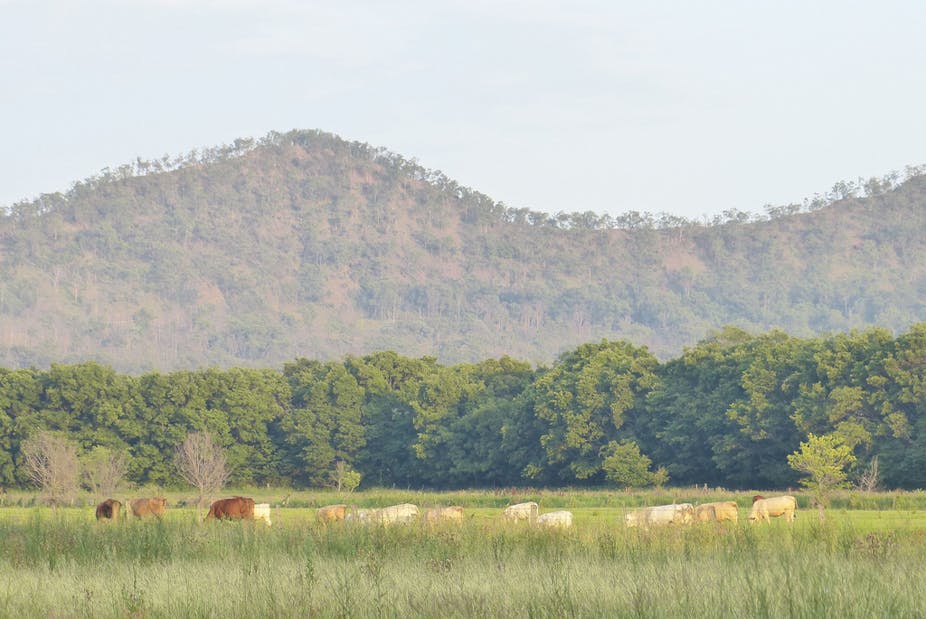Queensland farmers are used to dealing with variable seasons, but the long-term shifts of climate change are expected to create new challenges.
Queensland farmers already do a good job of managing a variable climate, and researchers have developed several popular climate analysis tools. Tools like the CliMate App - which lets users interrogate climate data and apply them to agriculture - are popular with growers, researchers and agribusinesses.
In Queensland our best farmers are already producing crops, fibre and meat operating very close to the maximum of the achievable productivity, under present technology. This means that the impact from expected changes in climate could still be significant in terms of reductions in profits and increases in risks e.g. profit variability from season to season.
Which farms will do well?
We recently simulated the impacts of a climate change scenario on the expected profits and risks of different types of farms in Queensland.
An irrigated farm business from Dalby was largely resilient to the impacts of this climate change scenario. Their capacity to irrigate crops gives the farmer from Dalby independence from in-season or season-to-season variation in rainfall. Though still, relatively small irrigated farms in the region are highly vulnerable to reductions in water allocations and increases in energy or labour costs.
A mixed cropping and grazing farm from Roma had reduced profits and increased risks. Relatively larger mixed-cropping and grazing farms that grow pastures as well as grain crops are more resilient to changes in rainfall. This is because these farms have diversified their sources of income with activities that have different sensitivity to drought, e.g. grasses are less sensitive than grain crops to temporary water shortages.
Rain-fed cropping farms in Goondiwindi and Emerald had more significant reduction in farm profits and increases in risks. Medium sized farms that grow more drought-sensitive grain crops like maize, wheat and chickpeas have fewer or no income options during the poorer drier seasons.
Even though there is evidence that climate change is likely to impose important stresses on most natural and managed systems, these changes are likely to still be perceived and managed as another source of climate variability.
Are we doing the right sort of research and development?
Farmers, like all of us, make two types of decisions to cope with change: decisions about the more urgent and certain issues in day-to-day activities, and those that are driven by medium to long-term goals and a less certain future. But there is an added complication: in farm businesses, the outcome of any decision will be closely related to changes in climate patterns – the short term climate variability. This is the case now, and it will continue to be the case in 30 years time, regardless of the trajectory of greenhouse gas emissions and climate change.
Unfortunately, since Land and Water Australia was closed in 2009, funding for research and development to manage climate variability has significantly dwindled.
The Australia’s Farming Futures - a program that ran between 2010 and 2012 - provided funding to support farmers’ adaptation to climate change. But the present Carbon Farming and Carbon Farming Futures initiatives mostly focus on mitigating emissions and sequestering carbon in soils. As a result, the focus and effort of most research and development providers has rapidly tuned to the new music: mitigation of greenhouse gas emissions and carbon sequestration.
Considering that farmers best respond to “fast” variations (season to season changes in climate and/or market), and not to “slow” climate changes, the value of the information produced by these programs to support on-farm decision making is rather limited. This also shows how the focus of the funding for research and development can dramatically change direction every three years, driven by Federal policy agendas such as carbon pricing rather than by ideas’ merit in science, innovation or practical relevance.
Providing information on the costs and benefits of various options for adapting to possible future climate change is unlikely, by itself, to change how farmers strategically plan their businesses. Alternative strategies may consider supporting programs that better bridge farmers’ responses between “fast” and “slow” drivers of change.
The information farmers need
Of course there are uncertainties about the direction, intensity and timeframe of the expected changes in climate. Nonetheless, we still have to talk about how farming systems react to “fast” and “slow” acting stresses. We find that the best way to do that is through discussions with farmers about the benefits and trade-offs from alternative adaptation pathways.
Governments and researchers should be supporting farmers with relevant and actionable information. They need to know how to make the most of the opportunities of a highly variable climate; they need to know how to cope with reductions in the terms of trade and the increases in input and labour costs; and they need to know how to break through ceiling productivity gains. These issues should provide focus for research, development and extension investments.
Results from such research would leave farmers better prepared to deal with the less certain and more difficult future for agriculture. We think that these will be crucial elements in the design of more resilient and productive farming systems in Queensland and Australia.

